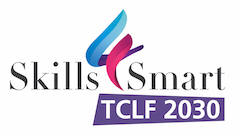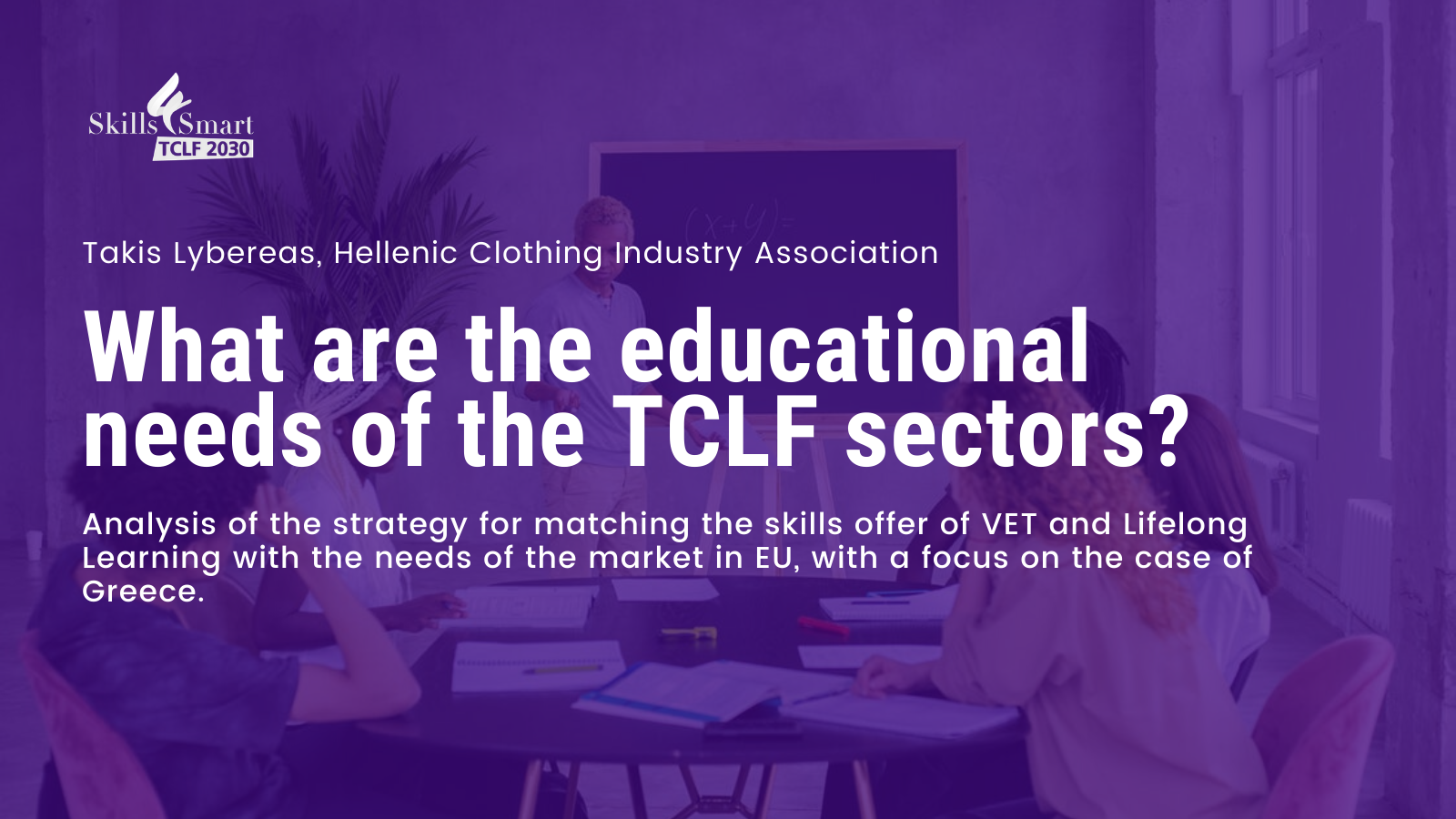Discover how companies and SMEs of the TCLF sectors have evolved since 1995, what are the most significant challenges faced by the TCLF sectors in EU, and what is the strategy for matching the skills offer of VET and Lifelong Learning with the needs of the market in EU, with a focus on the case of Greece.
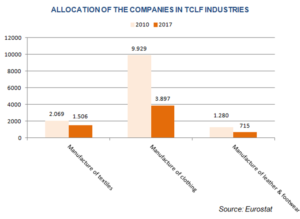
In 2019, a total of 6.080 companies were active in the Textile – Clothing – Leather – Footwear (TCLF) sectors in Greece.
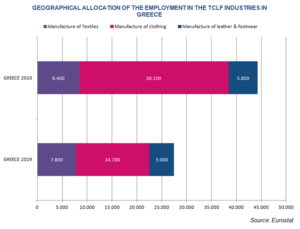
The TCLF companies employed a total of 27.500 employees. Most employees were in clothing (14.700 individuals), followed by Textiles with 7.800 and footwear – leather sector with 5.000 employees.
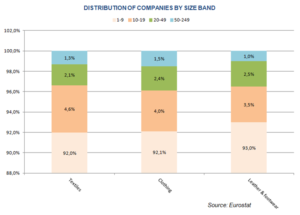 Most businesses (91.5%) are very small enterprises and employ 1 to 9 employees. Companies employing 10 – 19 workers account for 4.2%, companies with 20 – 49 workers account for 2.3%, and those with 50 – 250 employees for 1, 2 %, whilst very few enterprises employ more than 250 workers.
Most businesses (91.5%) are very small enterprises and employ 1 to 9 employees. Companies employing 10 – 19 workers account for 4.2%, companies with 20 – 49 workers account for 2.3%, and those with 50 – 250 employees for 1, 2 %, whilst very few enterprises employ more than 250 workers.
Between 1995 and 2015, especially in the clothing sector, took place a significant transfer of production activities to third countries, mainly to the Balkans (Bulgaria, Northern Macedonia, Albania, Romania). Meanwhile, since 1995, TCLF industries experienced significant changes: they gradually improved the production of high added-value products, they developed new services specially tailored to the needs of foreign customers, they established a vertical integration in distribution (retail), etc. During this period, the transformation from a primarily subcontracting industry to a new modern business model was completed. The modernization of TCLF industries, the geographical shift of product assembly works, and the new conditions that prevailed in the international market led to the shrinking of these industrial sectors. A significant number of companies, mainly subcontractors, employing many blue-collar workers, failed to transform and were forced to stop their activities.
At the same time, during this period Vocational Education and Training (VET) for the TCLF sectors in Greece was downgraded in comparison to its added value in the labor market. The main consequence was qualifications and skills acquired by the students with the actual desired mix of knowledge, qualifications, and skills required by the industries. This period of transition from an old business model to a new VET-driven system, especially in recent years, resulted in the shrinking to a minimum level – even to zero – the offer of quality training for the TCLF sectors.
The matching of Vocational Education and Training (VET) and Lifelong Learning (LLL) programmes with the real needs of the market in the TCLF sectors was not realized mainly due to:
- An active employment policy, such as vocational training, was transformed into a passive one, often under the pretext of an institutional framework for competition and state aid. Significant resources, for the vocational training of employees and unemployed, were channeled with exaggeration, to useless horizontal theoretical subjects, without the necessary vertical – sectoral specialisation;
- The lack of cooperation and the fragmented social dialogue between the social partners, the sectoral industry-representative bodies, and all the Ministries that supervise vocational education and initial vocational training schools;
- The educational services provided are implemented in an outdated technological environment, inconsistent with the business reality and the medium-term perspectives of the industries.
The whole situation resulted in the loss of interest of young people in seeking a professional career in the TCLF industries, subsequently resulting in the lack of new, well-trained technical and executive staff. The problem became more acute especially for skilled craftsmen with specific production skills who were never trained with new production methods and technological developments.
Similar conditions prevail in many other EU countries, creating severe troubles in many EU regions that were heavily dependent on the sector.
The issue of reforming VET systems and mobilizing young people to choose occupations in TCLF is a common goal for many EU countries. The major European sectoral organizations EURATEX – CEC – COTANCE are working together with 19 other partner organisations on the implementation of an important EU-funded project, Skills4SmartTCLF, aiming to develop a sustainable upskilling and reskilling strategy for the sectors for 2030.
10 most significant challenges faced by the TCLF sectors in EU

A basic purpose of the Skills4SmartTCLF project and the sectors’ organizations in Greece is among others the restructuring of Vocational Education and Training (VET) and Lifelong Learning (LLL) systems. The sectoral organizations in Greece and the Skills4SmartTCLF project have formulated a series of proposals and initiated a dialogue aiming to reshape the overall training framework for the sector.
The new framework must consider the need for continuous matching between the training offer and the emerging needs for skilled human resources to achieve a real educational restructuring and upgrading. This is the only way to achieve economic prosperity and genuine restructuring and upgrading education for the sectors. At the same time, the proposals should support the productive reconstruction and differentiation of production, providing the industry with appropriate executives and especially with technical staff.
Industry organizations have initiated a relevant dialogue with the authorities and have presented the current findings and results of the Skills4SmartTCLF project. Based on these data and the specific needs of the industry in Greece, they have proposed that the new National VET and Lifelong Learning System, which is under development, should aim to improve the existing operational structures of VET and LLL providers. It must focus on the existing needs of the production sectors related to the facilitation of the production of added-value goods and the increase of automation and digitization, with a view to the upcoming fourth industrial revolution, which would require continuous training and adaptation to new skills.
The new under construction educational system should also aim to the adaptation and modernization of the industries, through the development of certified human resources and through the establishment of institutional conditions in the following fields:
- Maintaining the integration of the activities of Lifelong Learning Centers in the new system of governance, for the uninterrupted provision of professional skills in technical education specialties to produce multi-level professional qualifications of the National / European Qualifications Framework.
- Lifelong Learning Centers offering corresponding specializations, are proposed to be placed under the supervision of the Ministry of Development and Investment with the same operating conditions, and with the possibility of providing training at all levels. The role of the National Organisation for the Certification of Qualifications & Vocational Guidance (EOPPEP) may oversee the certification process, but not the operation itself.
- Development of working groups in areas of the education system, with the participation of sectoral entrepreneurship institutions to promote vertical-sectoral skills and specializations. In addition, cooperation of VET providers with scientific institutes and organizations.
- Integration and cooperation through consultation procedures, between the Ministry of Education, entrepreneurship institutions, as well as other Ministries that supervise vocational education and training schools. To this end, the creation of special advisory committees by thematic field of vocational education could contribute significantly.
Takis Lybereas, HCIA
Learn more about Vocational Education and Training (VET): Recent trends in TCLF VET collaboration in EU, What is VET Excellence?, Webinar on VET Collaboration to restore growth in the TCLF sectors.
